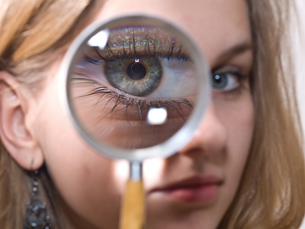Module 5
1. Module 5
1.26. Page 3
Module 5—Wave Theory of Light
 Read
Read
Read pages 677–679 of your textbook for more explanations and help in drawing ray diagrams for thin lenses.
The Lens Equation
While ray diagrams are useful tools for revealing image characteristics, they can also be used to derive a mathematical equation for finding and identifying image characteristics. The derivation of the lens equation, which is identical to the mirror equation in Lesson 3, can be seen on page 680 of your textbook.
The lens equation relates the focal length of a curved lens to the image and object positions.
Expressed as an equation, it is as follows:
![]()
| Quantity | Symbol |
SI Unit |
object position relative to the optical centre |
do |
m |
image position relative to the optical centre |
di |
m |
focal length |
f |
m |
The image and object characteristics are also described in these equations using sign conventions:
- Positive distances describe real images and objects.
- Negative distances describe virtual images.
- Converging lenses have a real focal length that is positive.
- Diverging lenses have a virtual focal length that is negative.
![]()
- Negative height describes an inverted image or object.
- Positive height describes an upright image or object.
 Read
Read
Read “Equations for Thin Lenses” on page 680 of the textbook.
 Try This
Try This
TR 1. Complete “Practice Problems” 1–3 on page 681 of the textbook.
 Module 5: Lesson 5 Assignment
Module 5: Lesson 5 Assignment
Remember to submit your answers to A 1, A 2, and A 3 to your teacher as part of your Module 5: Lesson 5 Assignment.
A 1. A lens with a focal length of 5.0 cm is placed 12 cm away from an 8.0-cm-tall object.
- How far from the lens is the image?
- How tall is the image?
- Describe the image characteristics: real/virtual, inverted/erect, enlarged/smaller.
A 2. A scientist uses a lens with a 17-cm focal length to focus light to create a holograph. The lens is 30 cm from the 25-cm-tall image.
- How far from the lens is the object?
- What is the height of the image?
- Describe the image characteristics: real/virtual, inverted/erect, enlarged/smaller.
A 3. A student is given the challenge of determining the focal length of the lens in an LCD projector. The projector creates an image 600-cm-tall 12 m from the lens. The object is 12-cm-tall.
- What is the distance to the object?
- What is the focal length of the lens?
 Discuss
Discuss

© luchschen/shutterstock
A magnifying glass is a double-convex converging lens. Using a ray diagram, prove that the magnified image you see in a magnifying glass is a virtual image. Explain how the focal length of the lens and the position of the object affect its magnifying power.
Your posting should consist of at least one ray diagram and an explanation relating the focal length and the object’s position to the amount of magnification and the characteristics of the image.
D 1. Using the simulation, you can explore ray diagrams for a magnifying glass by positioning the object inside the focal point of a converging lens on the simulation. Compare different positions to find how they relate to the object’s magnification and image characteristics. Also, adjust the focal length on the simulation, which defaults to 10.0 units of length.
D 2. Create rules to describe the relationship between the object distance and image distance relative to the focal point and real/virtual images. Post your rules and read the rules of other students in your discussion forum.
 Module 5: Lesson 5 Assignment
Module 5: Lesson 5 Assignment
Remember to submit your answer to D 3 to your teacher as part of your Module 5: Lesson 5 Assignment.
D 3. Now that you have seen other students’ rules, reflect on your rules and improve them. What are your new rules, and how did reading the other students’ rules help you to improve your own understanding?
Discussion Scoring Guide
| Principles involved: refraction, lens, and ray diagrams | ||||
Criteria |
Level 1 |
Level 2 |
Level 3 |
Level 4 |
Knowledge |
||||
Demonstrates a vague and sometimes incorrect understanding of the physics principles involved. Obvious irrelevant or missing information. |
Demonstrates a basic understanding of the physics principles involved. May exhibit minor mistakes or vague information or application to the situation. |
Demonstrates a good understanding of the physics principles involved and applies them properly to the given situation. All necessary information is given. |
Demonstrates a superior understanding of the physics principles involved and their application to the situation. All applications are considered in detail. |
|
Reflection |
||||
The post shows reflection on one’s own and other students’ work. Contributes to the group discussion. |
Does not make an effort to participate. Seems indifferent to discussion. |
Occasionally makes meaningful reflections on the group’s efforts or discussions. Marginal effort is shown to become involved with the group or discussion. |
Frequently makes meaningful reflections on the group’s efforts and presents relevant viewpoints for consideration by the group. Interacts freely with group members. |
Regularly attempts to motivate the group discussion and delve deeper into concepts. Interacts freely and encourages all group members. |
Content and presentation of discussion summary |
||||
The information is logically arranged in a clear and concise manner. |
The information is poorly organized with many concepts implied. Irrelevant or rambling sentences make reading difficult. |
The information is somewhat organized with implied concepts. Excessive words or awkward sentences are used, which hinder reading. |
The information is well-organized and logically arranged. All concepts are explicitly explained. There are a few awkward but understandable sentences. |
The information is well-organized and very easy to understand. Well-worded sentences make reading pleasurable. |